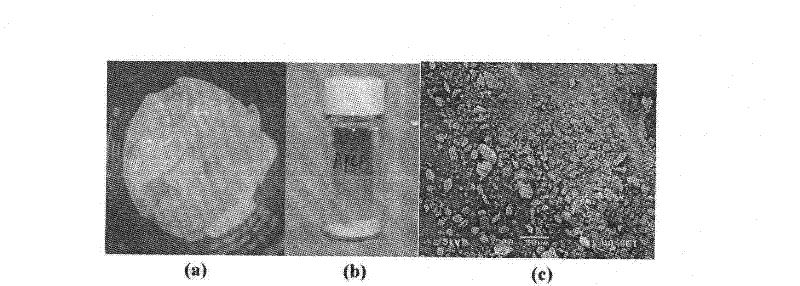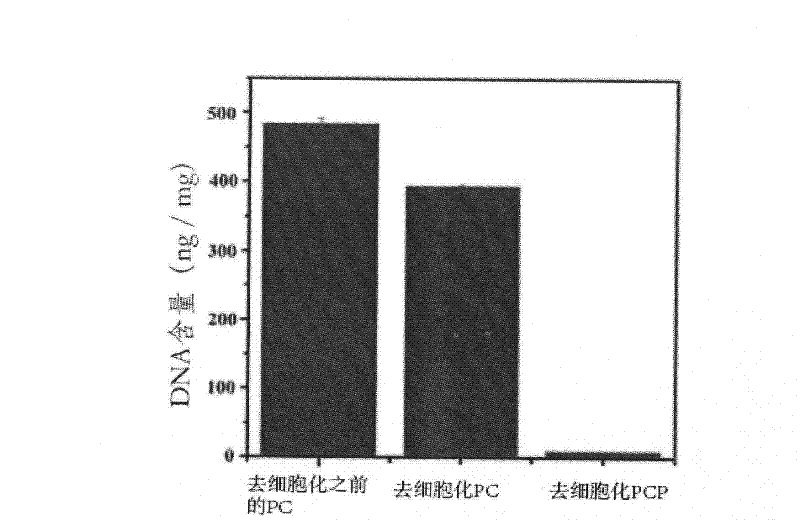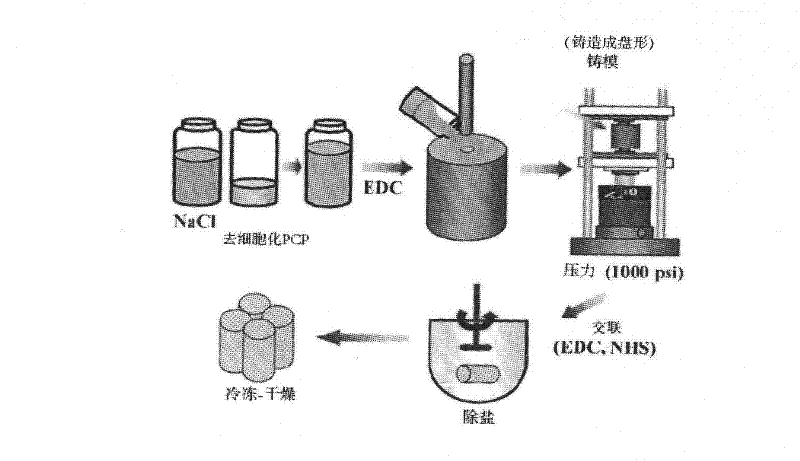Method for manufacturing a porous three-dimensional support using powder from animal tissue, and porous three-dimensional support manufactured by same
An animal tissue and powder technology, applied in tissue regeneration, prosthesis, drug delivery, etc., can solve the problem that the size, porosity, shape and structure of the scaffold are easily limited, and it is not disclosed to make three-dimensional structures with various sizes, shapes and structures. stents and other problems, to achieve good biocompatibility, good clinical practicability, and the effect of enhancing regeneration
- Summary
- Abstract
- Description
- Claims
- Application Information
AI Technical Summary
Problems solved by technology
Method used
Image
Examples
Embodiment 1
[0066] Embodiment 1: Pulverize porcine cartilage
[0067] The washed cartilage slices were pulverized to reduce their size to about 2×2 mm by a well-known and well-used commercial pulverizer (Hood Mixer HMF-505, Hanil Co., Ltd., Korea) by those skilled in the art. The crushed cartilage slices were freeze-dried, and then the freeze-dried cartilage slices were ground into a powder with a size of about 10 μm by a freeze mill (JAI, JFC-300, Japan).
[0068] 1-1. Morphological analysis of porcine cartilage powder
[0069] The morphology of porcine cartilage powder was analyzed by scanning electron microscope. The porcine cartilage powder prepared in Example 1 was treated with 2.5% glutaraldehyde for about 1 hour, and then washed with phosphate buffer solution. The sample was dehydrated and dried, and then observed with a microscope (JEOL, JSM-6380, Japan; 20KV) to measure the size and shape of the powder. After observation, the size of the powder is about 10 μm ( figure 1 (...
Embodiment 2
[0070] Example 2: Decellularization and properties of porcine cartilage powder
[0071] 2-1. Decellularization of porcine cartilage powder
[0072] In order to remove chondrocytes and genetic components to obtain pure extracellular matrix, decellularization will be performed as follows.
[0073] The porcine cartilage powder prepared in Example 1 was added to 1 liter of 0.1% sodium dodecyl sulfate (sodium dodecyl sulfate, SDS, Bio-Rad, the U.S.) (porcine cartilage powder of every 10 g), and stirred at 100 rpm for 24 Hour. After the SDS treatment, the product was washed with triple distilled water for 5 times at 100 rpm for 30 minutes.
[0074] In order to allow the cartilage powder to settle to replace the rinsing solution, the cartilage powder was spun at 10,000 rpm in an ultracentrifuge (US-21 SMT, Vision, Korea) for 1 hour.
[0075] 200ml of 200U / ml deoxyribonuclease (Sigma, USA) was added to the cartilage powder and stirred at 100rpm at 37C for 24 hours. The product...
Embodiment 3
[0082] Example 3: Using decellularized porcine cartilage powder to manufacture a three-dimensional scaffold and explain its characteristics
[0083] 3-1. Fabrication of porous three-dimensional scaffold
[0084] The decellularized cartilage powder prepared by the same procedure as in Example 2-1 was uniformly mixed with sodium chloride (with a crystal size of 250 to 350 μm) at a ratio of 1:9. Then, a solution prepared by 100 mM EDC (N-(3-dimethylaminopropyl)-N-ethylcarbodiimide hydrochloride) (Sigma, USA) and triple distilled water was added to the mixed solution at a ratio of 10%.
[0085] The EDC solution is uniformly mixed with the mixed solution of the cartilage powder and sodium chloride. Then the above mixed solution was poured into a self-made cemented carbide mold, and molded by 1000 psi pressure casting to make a disc-shaped product. The casting mold includes a fixed component and a moving component, and forms a three-dimensional support in the fixed component a...
PUM
| Property | Measurement | Unit |
|---|---|---|
| porosity | aaaaa | aaaaa |
Abstract
Description
Claims
Application Information
 Login to View More
Login to View More - R&D
- Intellectual Property
- Life Sciences
- Materials
- Tech Scout
- Unparalleled Data Quality
- Higher Quality Content
- 60% Fewer Hallucinations
Browse by: Latest US Patents, China's latest patents, Technical Efficacy Thesaurus, Application Domain, Technology Topic, Popular Technical Reports.
© 2025 PatSnap. All rights reserved.Legal|Privacy policy|Modern Slavery Act Transparency Statement|Sitemap|About US| Contact US: help@patsnap.com



